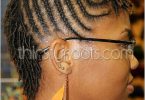There are many cornrows designs for men. These are all based on an ancient tradition that can be traced back for thousands of years. In fact, evidence of these hairstyles have been found on hieroglyphs and sculptures that date around 500 B.C. This evidence has been found in Africa, Nigeria, and especially in Egypt, where you can see the tight braiding down the back of the head of the Sphinx.
A lot of work goes into braiding these hairstyles. They are indeed more than just simple braids, but braids that start tight at the scalp and work their way outward. Using an upward, underhand motion the hair is grouped together to form rows. This is the most basic design, but you can literally use this simple concept as the basis for much more elaborate designs.
In fact, in ancient societies, these ornate styles were used to distinguish one group of people from another. Sometimes this included using beads or shells as well as the handmade braids. These materials, of course, were usually determined by simple geography.
Despite these ornamental methods, cornrow hairstyles are quite conventional. While it can take hours to finish one person’s hair, it is often worth it because you can leave cornrows in for many weeks at a time, even a month or so. You can wash them just like regular hair but you do need to apply a bit of oil every so often or your scalp and hair can dry out.
Although cornrow hairstyles have been around for centuries, it didn’t begin to become popular or common until very recently. The Black Pride Movement and the Civil Rights Movement of the 1960s were major catalysts in the re-introduction of these hairstyles as African Americans sought to reclaim their lost heritage. One way that they were able to do so was through the resurrection of natural, African hair styles.
Out of this came a need for professional stylists who have mastered the techniques that are involved with this method of hair styling. These professionals, then, opened beauty salons and barber shops that were dedicated to these specialty hairstyles.
The entertainment industry has also helped to support this development. As more African Americans found success in music, movies, and television, traditional African hairstyles became part of their artistic identity. As they became more popular and successful, their fans also desired to get more in touch with this ancient practice.



